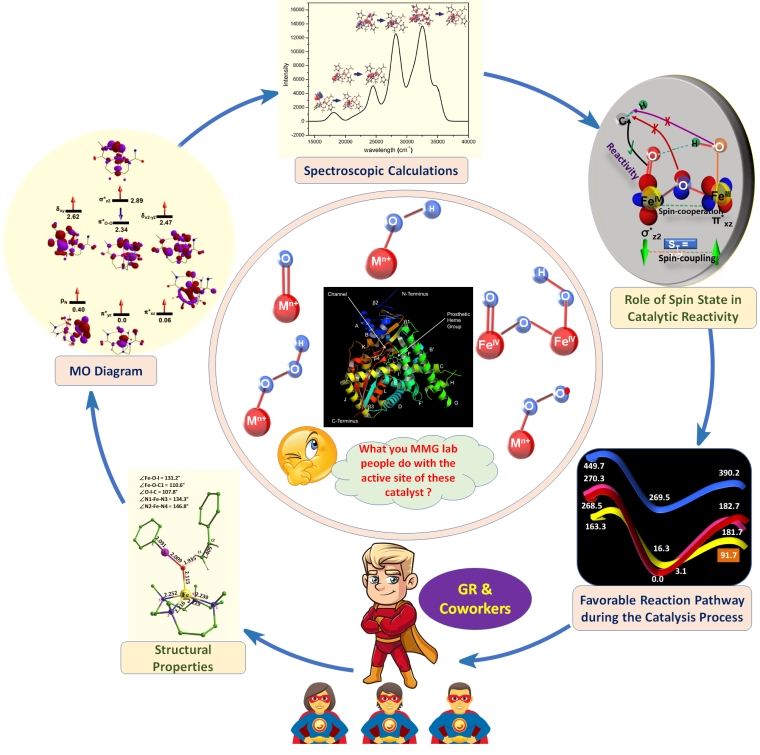Catalysis
Nowadays the C-H/O-H/N-H bond activations are important applications in biological and industrial processes. High-valent first-row transition metal complexes are serving an astonishing paradigm for the highly efficient and selective C-H/O-H/N-H bond activation reactions and providing several catalytic transformation reactions such as dehydrogenation, halogenation, hydroxylation, amination, olefin epoxidation, water splitting, etc. These reactions have applications in the pharmaceutical industries and also provides a suitable platform for understanding relevant enzymatic reactions.
There is general issue persist in metal-mediated catalytic reactions today are; (1) what is the nature of species involved in the catalytic reactions? (2) What is the exact mechanism of the catalytic transformations? (3) What are the specific reasons for the selectivity and the efficiency of a particular catalyst? (4) How can be tune ligands design?
(5) How spectroscopic parameters (such as IR, Raman, UV-Vis, EPR, Mossbauer) can help to fine-tune electronic structures? And ultimately (6) Can a model complex be made which could mimic all the functions and efficiency of the enzyme?

Being a computational chemist, our aim to understand the reaction mechanism of C-H/O-H/N-H bond activation reactions involving various spin states of biomimetic model complexes and the extension of that knowledge to the design and prediction of the selective catalysts of practical use. We generally employ Gaussian09, ORCA, Aomix suite to calculate the nature of transition state, mechanism of the reaction, rate-limiting step, energetics of the reaction, structure, and bonding, spectroscopic properties to corroborate experimental observations and make predictions towards the novel approach of chemical reactions.
Our group has investigated a detailed mechanistic study on the ortho-hydroxylation of aromatic compounds by non-heme iron complexes and our calculations show that the transient Fe(V)=O species prefers an electrophilic attack on the benzene ring rather than the usual aromatic C-H activation step. Apart from the mechanistic part, we have also highlighted the importance of ligand design in this chemistry and suggested that this concept can be used to enhance the reactivity and efficiency of the oxidants by increasing the electrophilicity of the ferryl oxygen atoms.
C-H Bond Activation by metal-oxo/superoxo species
Here we focused on comparative oxidative abilities of metal superoxo species towards the C-H bond activation reaction and also compared the reactivity with corresponding metal-oxo species. We have also established a correlation between C-H bond reactivity and magnetic exchange with metal-superoxo species for the first time. Our findings suggest that magnetic-exchange plays a crucial role in C-H bond activation.
M-oxo vs Fe-NTs vs Dinuclear metal-oxo species
Our computational analysis reveals that the Fe(IV)=NTs species are expected to be more reactive than the corresponding Fe(IV)=O intermediates and the possibility of having an S=3 state for the Fe(IV)=NTs offers room for further enhancement of reactivity.
The biomimic heme and non-heme mononuclear Fe(IV)=O complexes are very popular in this area and have been thoroughly studied over the years. These species despite possessing aggressive catalytic ability, cannot easily activate inert C–H bonds such as those of methane. In this context dinuclear complexes have gained attention, particularly dinuclear iron-oxo species reported lately exhibits remarkable catalytic abilities towards substrates such as methane. A strong spin-cooperation between the two iron centres also reduces the barrier for hydrogen atom abstraction, thus making the faster reaction. Both the spin-state as well as spin- coupling between the two metal centres play a crucial role in dictating the reactivity for dinuclear species. By exploring various mechanistic pathways for dinuclear iron-oxo species, our study unveils the fact that the bridged μ-oxo group is a poor electrophile for both C–H activation as well for –OH rebound. As more and more evidence is gathered in recent years for the open core geometry of sMMO enzymes, the idea of enhancing the reactivity via an open-core motif has far-reaching consequences.